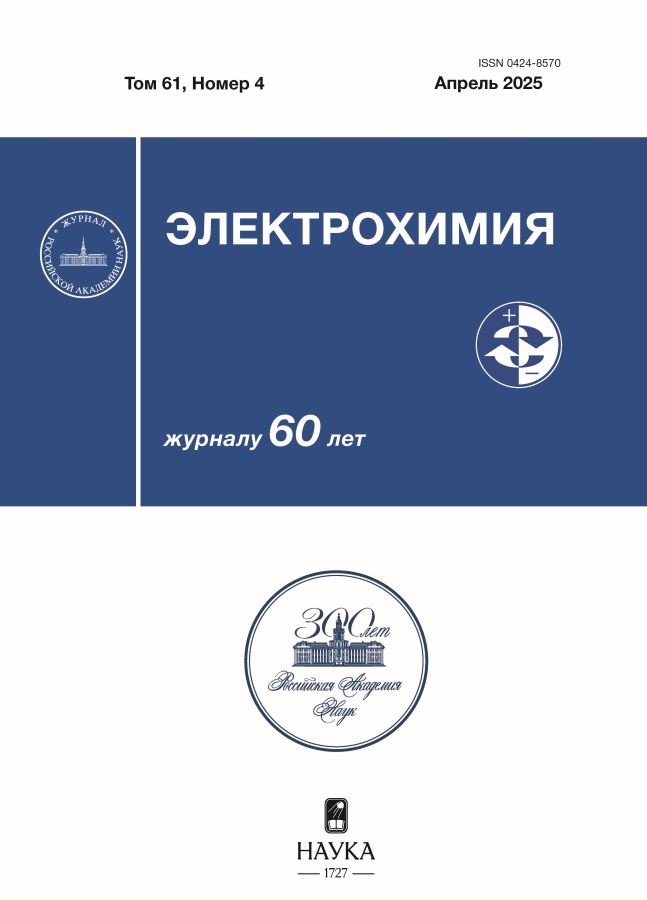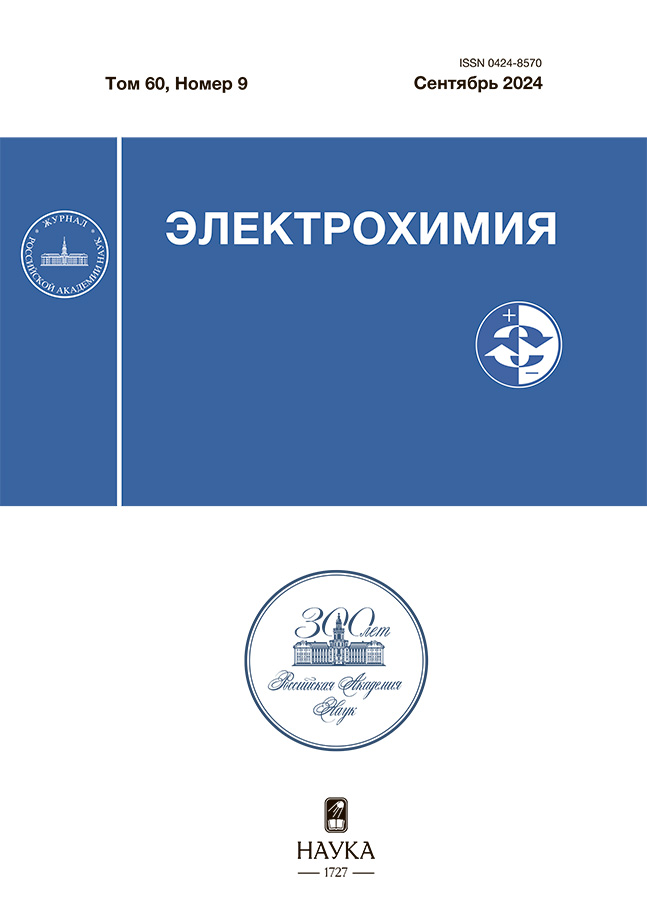Единичная ячейка водородно-ванадиевого проточного источника тока с высокой удельной мощностью разряда
- Авторы: Истакова О.И.1, Конев Д.В.1,2, Толстель Д.О.3, Рубан Е.А.1,2, Красикова М.С.1, Воротынцев М.А.2
-
Учреждения:
- Федеральный исследовательский центр проблем химической физики и медицинской химии РАН
- Институт физической химии и электрохимии им. А. Н. Фрумкина РАН
- Московский государственный университет имени М. В. Ломоносова
- Выпуск: Том 60, № 9 (2024)
- Страницы: 611-626
- Раздел: Статьи
- URL: https://www.clinpractice.ru/0424-8570/article/view/684858
- DOI: https://doi.org/10.31857/S0424857024090033
- EDN: https://elibrary.ru/OIAMAA
- ID: 684858
Цитировать
Полный текст
Аннотация
В работе исследован проточный химический источник тока, мембранно-электродный блок которого представляет собой гибрид газодиффузионного анода водородно-воздушного топливного элемента (ТЭ) и катода ванадиевой проточной редокс-батареи (ВПРБ), работающего за счет циркуляции сернокислого раствора солей ванадия в степени окисления +4 и +5 через пористый углеродный материал:
(Pt–C)H2|Nafion|VO2+(С). Концепция одородно-ванадиевой проточной батареи (ВВПБ) была предложена ранее (2013 г.) в качестве альтернативы ВПРБ для решения задач накопления/воспроизводства электроэнергии в накопителях большой емкости, однако ее практическая реализация до настоящего времени ограничена единичными ячейками с активной площадью не более нескольких десятков см2. Целью настоящей работы являлись выявление и минимизация факторов, ограничивающих удельную мощность разряда такого гибрида – по этому показателю ВВПБ уступают как водородно-воздушным ТЭ, так и ВПРБ, несмотря на сочетание их более обратимых полуэлементов. Объектом исследования выступала ячейка с мембранно-электродным блоком 2см × 2см, оснащенная капилляром Луггина со стороны ванадиевого электролита. С использованием шестиэлектродной схемы подключения ячейки выполнены измерения вольт-амперных характеристик, включая поляризации отдельных полуэлементов при варьировании скорости циркуляции ванадиевого электролита и материала катода (углеродные войлоки толщиной 4.6 и 2.5 мм, а также углеродная бумага). Установлено, что вклад водородного газодиффузионного электрода в полное сопротивление ячейки ВВПБ постоянному току вдвое превышает таковой для проточного ванадиевого катода. В работе получена рекордно высокая удельная мощность разряда: 0.75 Вт см–2, при этом в качестве материала катода использован коммерчески доступный материал – углеродный войлок Sigracell GFD 2.5 EA-TA без дополнительной модификации поверхности.
Полный текст
Об авторах
О. И. Истакова
Федеральный исследовательский центр проблем химической физики и медицинской химии РАН
Email: dkfrvzh@yandex.ru
Россия, Черноголовка
Д. В. Конев
Федеральный исследовательский центр проблем химической физики и медицинской химии РАН; Институт физической химии и электрохимии им. А. Н. Фрумкина РАН
Автор, ответственный за переписку.
Email: dkfrvzh@yandex.ru
Россия, Черноголовка; Москва
Д. О. Толстель
Московский государственный университет имени М. В. Ломоносова
Email: dkfrvzh@yandex.ru
Россия, Москва
Е. А. Рубан
Федеральный исследовательский центр проблем химической физики и медицинской химии РАН; Институт физической химии и электрохимии им. А. Н. Фрумкина РАН
Email: dkfrvzh@yandex.ru
Россия, Черноголовка; Москва
М. С. Красикова
Федеральный исследовательский центр проблем химической физики и медицинской химии РАН
Email: dkfrvzh@yandex.ru
Россия, Черноголовка
М. А. Воротынцев
Институт физической химии и электрохимии им. А. Н. Фрумкина РАН
Email: mivo2010@yandex.com
Россия, Москва
Список литературы
- Yufit, V., Hale, B., Matian, M., Mazur, P., and Brandon, N. P., Development of a regenerative hydrogen-vanadium fuel cell for energy storage applications, J. Electrochem. Soc., 2013, vol. 160, no. 6, p. A856.
- Moore, M., Counce, R., Watson, J., and Zawodzinski, T., A comparison of the capital costs of a vanadium redox-flow battery and a regenerative hydrogen-vanadium fuel cell, J. Adv. Chem. Eng., 2015, vol. 5, no. 4, p. 1000140.
- Dewage, H.H., Yufit, V., and Brandon, N.P., Study of loss mechanisms using half-cell measurements in a regenerative hydrogen vanadium fuel cell, J. Electrochem. Soc., 2015, vol. 163, no. 1, p. A5236.
- Dowd, R.P., Verma, A., Li, Y., Powers, D., Wycisk, R., Pintauro, p. N., and Van Nguyen, T., A hydrogen-vanadium reversible fuel cell crossover study, J. Electrochem. Soc., 2017, vol. 164, no. 14, p. F1608.
- Dowd, R.P., Lakhanpal, V.S., and Van Nguyen, T., Performance evaluation of a hydrogen-vanadium reversible fuel cell, J. Electrochem. Soc., 2017, vol. 164, no. 6, p. F564.
- Tenny, K.M., Lakhanpal, V.S., Dowd, R.P., Yarlagadda, V., and Van Nguyen, T., Impact of multi-walled carbon nanotube fabrication on carbon cloth electrodes for hydrogen-vanadium reversible fuel cells, J. Electrochem. Soc., 2017, vol. 164, no. 12, p. A2534.
- Muñoz, C.P., Dewage, H.H., Yufit, V., and Brandon, N.P., A unit cell model of a regenerative hydrogen-vanadium fuel cell, J. Electrochem. Soc., 2017, vol. 164, no. 14, p. F1717.
- Chakrabarti, B., Yufit, V., Kavei, A., Xia, Y., Stevenson, G., Kalamaras, E., Luo, H., Feng, J., Tariq, F., Taiwo, O., Titirici, M.-M., and Brandon, N., Charge/discharge and cycling performance of flexible carbon paper electrodes in a regenerative hydrogen/vanadium fuel cell, Int. J. Hydrogen energy, 2019, vol. 44, no. 57, p. 30093.
- Pino-Muñoz, C.A., Chakrabarti, B.K., Yufit, V., and Brandon, N.P., Characterization of a Regenerative hydrogen-vanadium fuel cell using an experimentally validated unit cell model, J. Electrochem. Soc., 2019, vol. 166, no. 15, p. A3511.
- Parra-Puerto, A., Rubio-Garcia, J., Cui, J., and Kucernak, A., High Energy Density Hydrogen/Vanadium Hybrid Redox Flow Battery Utilizing HCl As a Supporting Electrolyte, Electrochem. Soc. Meeting Abstracts prime 2020 – Electrochem. Soc., Inc., 2020, no. 4, p. 800-800.
- Chakrabarti, B.K., Feng, J., Kalamaras, E., Rubio-Garcia, J., George, C., Luo, H., Xia, Y., Yufit, V., Titirici, M.-M., Low, C.T.J., Kucernak, A., and Brandon, N.P., Hybrid redox flow cells with enhanced electrochemical performance via binderless and electrophoretically deposited nitrogen-doped graphene on carbon paper electrodes, ACS Appl. Mat. & Interfaces, 2020, vol. 12, no. 48, p. 53869.
- Chakrabarti, B.K., Kalamaras, E., Ouyang, M., Liu, X., Remy, G., Wilson, P.F., Williams, M.A., Rubio-Garcia, J., Yufit, V., Bree, G., Hajimolana, Y.S., Singh, A., Tariq, F., Low, C.T.J., Wu, B., George, C., and Brandon, N.P., Trichome-like carbon-metal fabrics made of carbon microfibers, carbon nanotubes, and Fe-based nanoparticles as electrodes for regenerative hydrogen/vanadium flow cells, ACS Appl. Nano Mater., 2021, vol. 4, no. 10. p. 10754.
- Hsu, N.Y., Devi, N., Lin, Y.I., Hu, Y.H., and Ku, H.H., Study on the effect of electrode configuration on the performance of a hydrogen/vanadium redox flow battery, Renewable Energy, 2022, vol. 190, p. 658.
- Dowd, R.P., Ying, A., and Van Nguyen, T., Preliminary study of a reversible hydrogen-vanadium flow battery, ECS Transactions, 2016, vol. 72, no. 10, p. 11.
- Weng, G.M., Li, C.Y.V., and Chan, K.Y., High-voltage pH differential vanadium-hydrogen flow battery, Mater. Today Energy, 2018, vol. 10, p. 126.
- Lee, C.Y., Chen, C.H., Chen, Y.C., and Jiang, X.F., A Flexible 7-in-1 Microsensor Embedded in a Hydrogen/Vanadium Redox Battery for Real-Time Microscopic Measurements, Membranes, 2022, vol. 13, no. 1, p. 49.
- Zhang, K., Zheng, X., Liu, S., Xie, Z., Liu, Z., Zhu, Z., Jiang, T., Wang, W., Wang, M., Ma, Y., Meng, Y., Peng, Q., and Chen, W., High-rate, two-electron-transfer vanadium-hydrogen gas battery, Electrochim. Acta, 2023, vol. 469, p. 143216.
- Feng, W., Zeng, Y., Deng, F., Yang, P., and Dai, S., A hydrogen-vanadium rebalance cell based on ABPBI membrane operating at low hydrogen concentration to restore the capacity of VRFB, J. Energy Storage, 2023, vol. 74, p. 109363.
- Ding, M., Liu, T., Zhang, Y., Liu, H., Pan, D., and Chen, L., Physicochemical and Electrochemical Characterization of Vanadium Electrolyte Prepared with Different Grades of V2O5 Raw Materials, Energies, 2021, vol. 14, no. 18, p. 5958.
- Li, X., Zhang, H., Mai, Z., Zhang, H., and Vankelecom, I., Ion exchange membranes for vanadium redox flow battery (VRB) applications, Energy & Environmental Sci., 2011, vol. 4, no. 4, p. 1147.
Дополнительные файлы

















